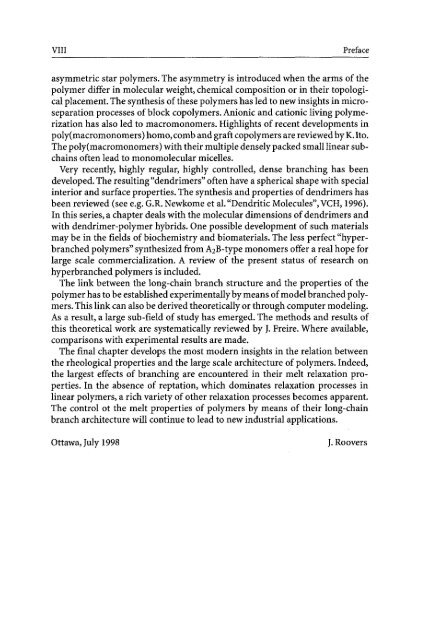142 Advances in Polymer Science Editorial Board: A. Abe. A.-C ...
142 Advances in Polymer Science Editorial Board: A. Abe. A.-C ...
142 Advances in Polymer Science Editorial Board: A. Abe. A.-C ...
You also want an ePaper? Increase the reach of your titles
YUMPU automatically turns print PDFs into web optimized ePapers that Google loves.
VIII Preface<br />
asymmetric star polymers. The asymmetry is <strong>in</strong>troduced when the arms of the<br />
polymer differ <strong>in</strong> molecular weight, chemical composition or <strong>in</strong> their topologi-<br />
cal placement. The synthesis of these polymers has led to new <strong>in</strong>sights <strong>in</strong> micro-<br />
separation processes of block copolymers. Anionic and cationic liv<strong>in</strong>g polyme-<br />
rization has also led to macromonomers. Highlights of recent developments <strong>in</strong><br />
poly(macromonomers) homo, comb and graft copolymers are reviewed by K. Ito.<br />
The poly(macromonomers) with their multiple densely packed small l<strong>in</strong>ear sub-<br />
cha<strong>in</strong>s often lead to monomolecular micelles.<br />
Very recently, highly regular, highly controlled, dense branch<strong>in</strong>g has been<br />
developed. The result<strong>in</strong>g"dendrimers" often have a spherical shape with special<br />
<strong>in</strong>terior and surface properties. The synthesis and properties of dendrimers has<br />
been reviewed (see e.g.G.R. Newkome et al."Dendritic Molecules", VCH, 1996).<br />
In this series, a chapter deals with the molecular dimensions of dendrimers and<br />
with dendrimer-polymer hybrids. One possible development of such materials<br />
may be <strong>in</strong> the fields of biochemistry and biomaterials. The less perfect "hyper-<br />
branched polymers" synthesized from A2B-type monomers offer a real hope for<br />
large scale commercialization. A review of the present status of research on<br />
hyperbranched polymers is <strong>in</strong>cluded.<br />
The l<strong>in</strong>k between the long-cha<strong>in</strong> branch structure and the properties of the<br />
polymer has to be established experimentally by means of model branched poly-<br />
mers. This l<strong>in</strong>k can also be derived theoretically or through computer model<strong>in</strong>g.<br />
As a result, a large sub-field of study has emerged. The methods and results of<br />
this theoretical work are systematically reviewed by J. Freire. Where available,<br />
comparisons with experimental results are made.<br />
The f<strong>in</strong>al chapter develops the most modern <strong>in</strong>sights <strong>in</strong> the relation between<br />
the rheological properties and the large scale architecture of polymers. Indeed,<br />
the largest effects of branch<strong>in</strong>g are encountered <strong>in</strong> their melt relaxation pro-<br />
perties. In the absence of reptation, which dom<strong>in</strong>ates relaxation processes <strong>in</strong><br />
l<strong>in</strong>ear polymers, a rich variety of other relaxation processes becomes apparent.<br />
The control ot the melt properties of polymers by means of their long-cha<strong>in</strong><br />
branch architecture will cont<strong>in</strong>ue to lead to new <strong>in</strong>dustrial applications.<br />
Ottawa, July 1998 J. Roovers
















